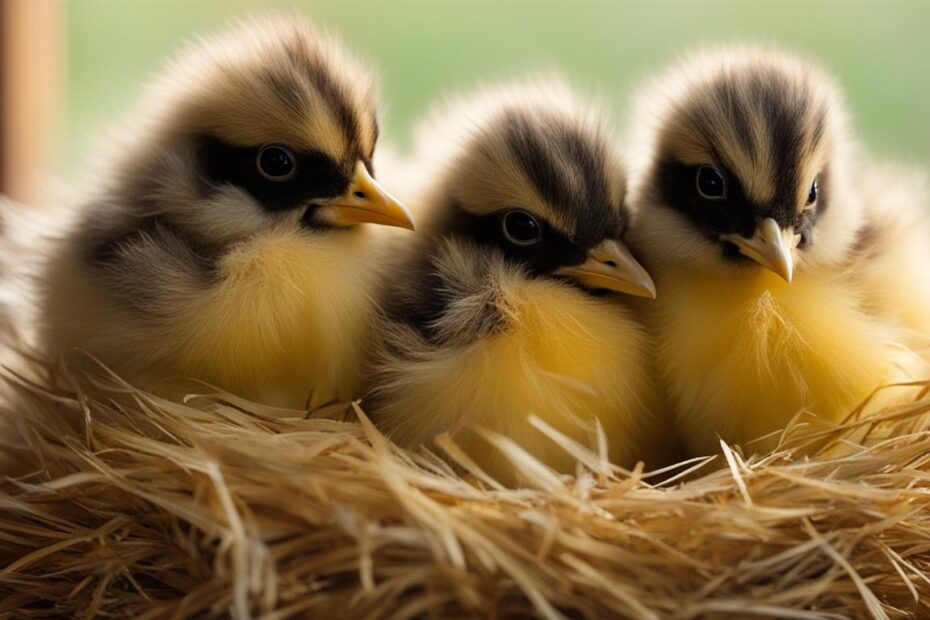Welcome to your comprehensive guide on raising fully feathered chicks at home. Whether you’re a seasoned chicken keeper or a beginner, understanding when and how to move chicks from the brooder to the chicken coop is crucial for their health and well-being.
In this article, we will cover the factors to consider when determining the right time to make the move, ensuring the chicks’ comfort during the transition, integrating them into an existing flock, and providing proper nutrition and care. By following these guidelines, you can create a safe and nurturing environment for your feathered friends.
Key Takeaways
- Wait until chicks are fully feathered, usually around 6 weeks old, before moving them to the coop.
- Consider the outside temperatures and ensure the coop is predator-proof before the move.
- Minimize stress during the transition by acclimating chicks to the coop and gradually introducing them to the outdoor environment.
- Integrate chicks into an existing flock gradually to prevent injury.
- Provide proper nutrition with a balanced chick starter feed and supplemental calcium and grit as needed.
Factors Affecting the Timing of Chick Movement
Moving chicks from the brooder to the coop requires careful consideration of several factors. The age and feathering of the chicks play a significant role in determining when they can make the transition. While most chicks are fully feathered by 6 weeks of age, the actual feathering should be taken into account rather than just the age. It is important to ensure that the outside temperatures remain above 65°F when moving the chicks to the coop. Additionally, coop considerations such as electricity availability and predator-proofing should also be taken into account.
Chicks should be moved to the coop when they are at least 6 weeks old and the outside temperatures are consistently above 65°F. This ensures that the chicks are able to tolerate the outdoor temperatures without the need for supplemental heat. By waiting until the chicks are fully feathered and the weather is suitable, the risk of cold stress is minimized.
Coop considerations play an important role in determining the timing of chick movement as well. The coop should have access to electricity if a heat source is required. It should also be secure and predator-proof, using hardware cloth to keep predators out and chicks in. Safety measures should be in place to prevent predators from getting into the coop and to ensure the chicks are protected.
Table: Factors Affecting the Timing of Chick Movement
| Factor | Considerations |
|---|---|
| Age and Feathering | Chicks should be at least 6 weeks old and fully feathered before moving to the coop. |
| Temperatures and Time of Year | Chicks should be moved to the coop when outside temperatures remain above 65°F. |
| Coop Considerations | The coop should have electricity availability and be predator-proof. |
Ensuring Chick Comfort During the Move
Moving chicks from the brooder to the coop can be a stressful experience for them. To minimize stress, it is important to instill the concept of home in the chicks. This can be done by keeping them inside the coop for several weeks prior to allowing them access to the run. Denying access to nest boxes is also important to prevent the chicks from developing the habit of sleeping in them. By providing a familiar and safe environment, the stress of the move can be reduced.
Creating a sense of home for the chicks is crucial for their well-being during the transition. This can be achieved by gradually introducing them to the coop environment over a period of time. Keeping them inside the coop for a few weeks prior to the move allows them to become accustomed to their new surroundings, reducing anxiety.
- Keep the chicks in the coop for several weeks before allowing access to the run.
- Deny access to nest boxes to prevent sleeping habit development.
- Provide a familiar and safe environment to reduce stress.
“A smooth transition involves gradually introducing the chicks to the coop environment, allowing them to become familiar and comfortable in their new home.” – Poultry Expert
Table: Steps to Ensure Chick Comfort During the Move
| Steps | Description |
|---|---|
| 1 | Keep the chicks inside the coop for several weeks before allowing access to the run. |
| 2 | Deny access to nest boxes to prevent the development of sleeping habits. |
| 3 | Create a familiar and safe environment in the coop to reduce stress. |
Integration into the Existing Flock
Introducing new chicks to an existing flock of older birds requires a slow and deliberate integration process. It’s crucial to wait until the chicks are closer in size to the mature birds before beginning the integration. This is because smaller chicks can be seriously injured by the pecking-order behavior of larger birds.
To ensure a smooth integration, it’s recommended to use the Playpen Method. This involves creating a separate space within the coop or run using a wire fence or chicken wire. This allows the chicks and older birds to see and interact with each other while preventing physical aggression. Gradually increase the amount of time the chicks and older birds spend together, closely monitoring their interactions.
During the integration process, it’s essential to provide plenty of space for the young and mature birds to move around. This helps reduce stress and minimizes the risk of aggression. Pay attention to signs of bullying or excessive pecking, which may require further separation or intervention. By taking the time to integrate the flock slowly and carefully, you can ensure a harmonious environment for all the birds.
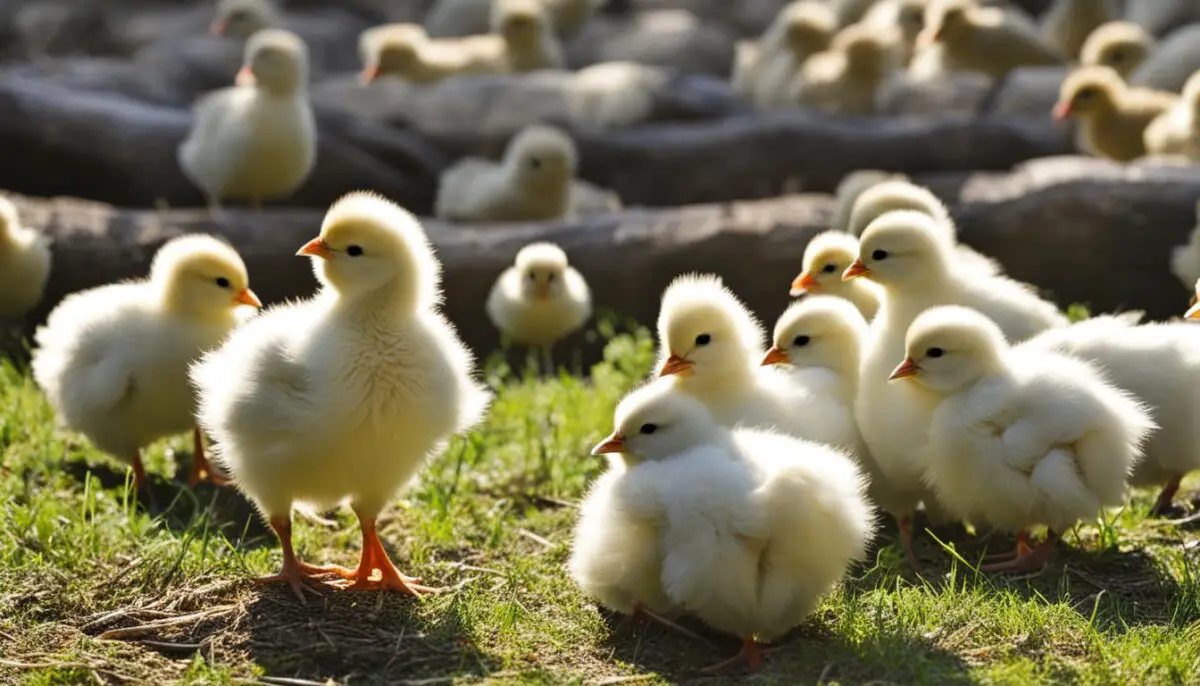
Table: Recommended Timeline for Integration
| Weeks of Age | Integration Steps |
|---|---|
| 6-8 weeks | Start with supervised interaction through wire fencing or chicken wire |
| 8-10 weeks | Increase the duration of interaction, allowing face-to-face encounters |
| 10-12 weeks | Allow for more integrated time, monitoring for signs of aggression |
| 12 weeks and older | Full integration, with close observation for any ongoing conflicts |
Determining the Need for a Heat Source
When it comes to moving chicks from the brooder to the coop, the need for a heat source depends on several factors, including the temperatures and the number of chicks. If the outdoor temperatures remain above 65°F (18°C) and the chicks are at least 6 weeks old, they can be moved into the coop without supplemental heat. This is because at 6 weeks of age, most chicks are fully feathered and better equipped to regulate their body temperature. However, it’s important to consider the number of chicks in your flock as well.
A larger number of chicks can generate more body heat and adequately keep each other warm when necessary. In this case, the need for a heat source may be reduced or eliminated altogether. It’s important to monitor the temperature inside the coop and ensure it remains within a comfortable range for the chicks. Utilizing a thermometer inside the coop can help you gauge the conditions and make informed decisions about the need for supplemental heat.
Table: Determining the Need for a Heat Source
| Outdoor Temperatures | Age of Chicks | Number of Chicks | Heat Source Required? |
|---|---|---|---|
| Above 65°F (18°C) | At least 6 weeks old | Small number | No |
| Below 65°F (18°C) | At least 6 weeks old | Small number | Consider monitoring temperature and providing supplemental heat if needed |
| Above 65°F (18°C) | At least 6 weeks old | Larger number | No, as large number of chicks can generate sufficient body heat |
| Below 65°F (18°C) | At least 6 weeks old | Larger number | Consider monitoring temperature and providing supplemental heat if needed |
Remember, it’s always better to err on the side of caution when it comes to the well-being of your chicks. If you have any doubts about the temperatures or the ability of the chicks to stay warm, providing a heat source, such as a heat lamp or heating pad, can help ensure their comfort and safety. By assessing the temperatures, considering the number of chicks, and monitoring their behavior, you can make informed decisions about the need for a heat source during the transition from the brooder to the coop.
Coop Considerations
Before moving the chicks to the coop, it is important to ensure that the coop meets certain requirements. The coop should have access to electricity if a heat source is required. It should also be secure and predator-proof, using hardware cloth to keep predators out and chicks in. Safety measures should be in place to prevent predators from getting into the coop and to ensure the chicks’ protection.
To ensure a secure coop, consider the following coop requirements:
- Use strong and sturdy materials to build the coop, such as wood or metal, and reinforce weak points to prevent predators from breaking in.
- Install hardware cloth on all openings, including windows, vents, and the entrance, to prevent predators from entering the coop.
- Provide a secure latch or lock on the coop door to keep it tightly closed at night.
“A predator-proof coop is essential to keep your chicks safe from harm. Take the time to properly secure the coop to protect your flock.”
Coop Safety Tips:
- Regularly inspect the coop for any signs of damage or weakness, and promptly repair any issues to ensure the coop remains secure.
- Consider installing an automatic door opener/closer to ensure the coop is securely closed at night, even if you are away.
- Keep the coop clean and free from debris to prevent attracting predators.
By meeting these coop requirements and implementing safety measures, you can provide a secure and predator-proof home for your chicks, ensuring their safety and well-being as they transition to the coop.
Providing Proper Nutrition and Care for Chicks
Raising baby chicks requires providing them with proper nutrition and care to ensure their health and development. Here are some essential considerations for setting up a brooder and providing the necessary food, water, and heat for your chicks:
Brooder Setup
The brooder setup is crucial for creating a safe and comfortable environment for your chicks. Choose a brooder box with high sides to prevent the chicks from jumping out. Curved or round shapes are preferred, as they help to prevent chicks from piling up in corners and getting crushed. Place a thin layer of bedding material, such as pine pellets or wood shavings, about 2 inches deep. This will provide insulation and absorb moisture.
Heat Lamp
A heat lamp is essential for keeping the chicks warm, especially during their early days when they haven’t fully developed their feathers. Hang the heat lamp about 18 inches above the brooder floor to maintain a temperature of around 95°F for the first two weeks. It’s important to have a thermometer to monitor the temperature regularly and make adjustments if necessary. Gradually reduce the temperature by 5°F per week until the chicks are fully feathered and ready for the outdoor temperatures.
Water and Food
Provide fresh water at all times for your chicks. Use a shallow water container, like a metal one, to prevent drowning. It’s recommended to offer water before introducing food to ensure the chicks have taken a drink. For optimal health and growth, feed your chicks a balanced chick starter feed. This feed is specifically formulated to meet the nutritional needs of young chicks. You can also provide supplemental feed, such as organic chick starter mix and vegetable scraps. Make sure to clean and refill the water and food containers regularly to maintain hygiene.
| Essential Items for Chicks | Recommended Quantity |
|---|---|
| Brooder box with high sides | 1 |
| Bedding material (pine pellets or wood shavings) | 2 inches deep |
| Heat lamp with bulb | 1 |
| Thermometer | 1 |
| Shallow water container | 1 |
| Chick starter feed | As per instructions |
Providing proper nutrition and care for your chicks in their early days is crucial for their health and development. Ensure a well-equipped brooder setup with suitable bedding, a heat lamp for warmth, and fresh water and balanced chick starter feed. By meeting their basic needs, you can set your chicks on the path to a healthy and vibrant life.
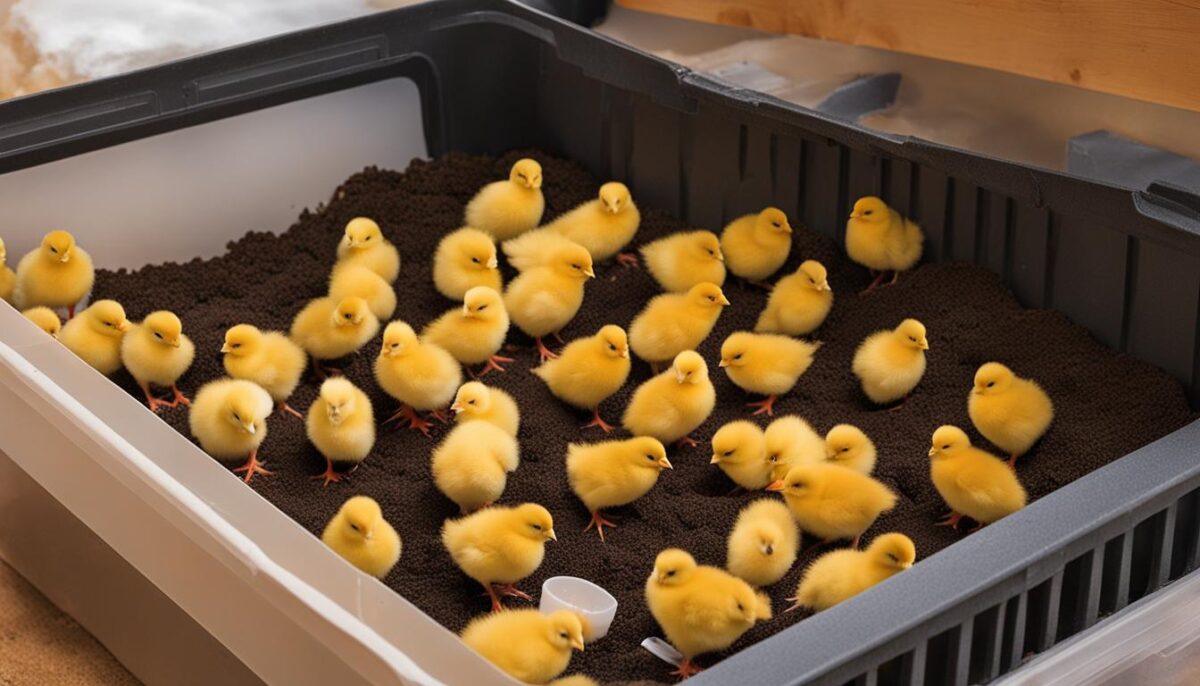
Transitioning Chicks from Heat Lamp to Coop
When transitioning chicks from the heat lamp to the coop, it’s important to consider the duration of heat lamp use and acclimating them to outdoor temperatures. The duration of heat lamp use depends on the age of the chicks and the outdoor temperatures. Proper acclimation to outdoor temperatures is crucial to ensure their well-being as they adjust to their new environment.
For the first two weeks, chicks should be kept under the heat lamp at a temperature of 95°F. This helps them maintain the warmth they need until their feathers are fully developed. After two weeks, you can gradually reduce the temperature of the heat lamp by 5°F each week. By the time the chicks reach six weeks of age, they are usually fully feathered and capable of tolerating outdoor temperatures.
However, if the outdoor temperatures are below 70°F, it’s advisable to slowly acclimate the chicks to the cooler temperatures. This can be done by allowing them short periods of supervised time outside during the day, gradually increasing the duration over time. This gradual exposure helps them adjust to the outdoor temperatures and reduces the risk of cold stress.
Remember, the transition from the heat lamp to the coop should be done gradually to ensure the chicks’ comfort and well-being. Paying attention to the duration of heat lamp use and properly acclimating them to outdoor temperatures are essential steps in raising healthy and happy chicks.
| Age of Chicks | Heat Lamp Temperature (°F) | Outdoor Temperature (°F) |
|---|---|---|
| 0-2 weeks | 95 | N/A |
| 2-3 weeks | 90 | N/A |
| 3-4 weeks | 85 | N/A |
| 4-5 weeks | 80 | N/A |
| 5-6 weeks | 75 | N/A |
| 6+ weeks | N/A | Gradual outdoor acclimation |
Water and Food for Baby Chicks
Proper hydration is crucial for the health and well-being of baby chicks. Water plays a vital role in their growth and development, as it helps regulate body temperature, aids in digestion, and supports overall bodily functions. Providing clean and fresh water is essential to ensure optimal hydration for your chicks.
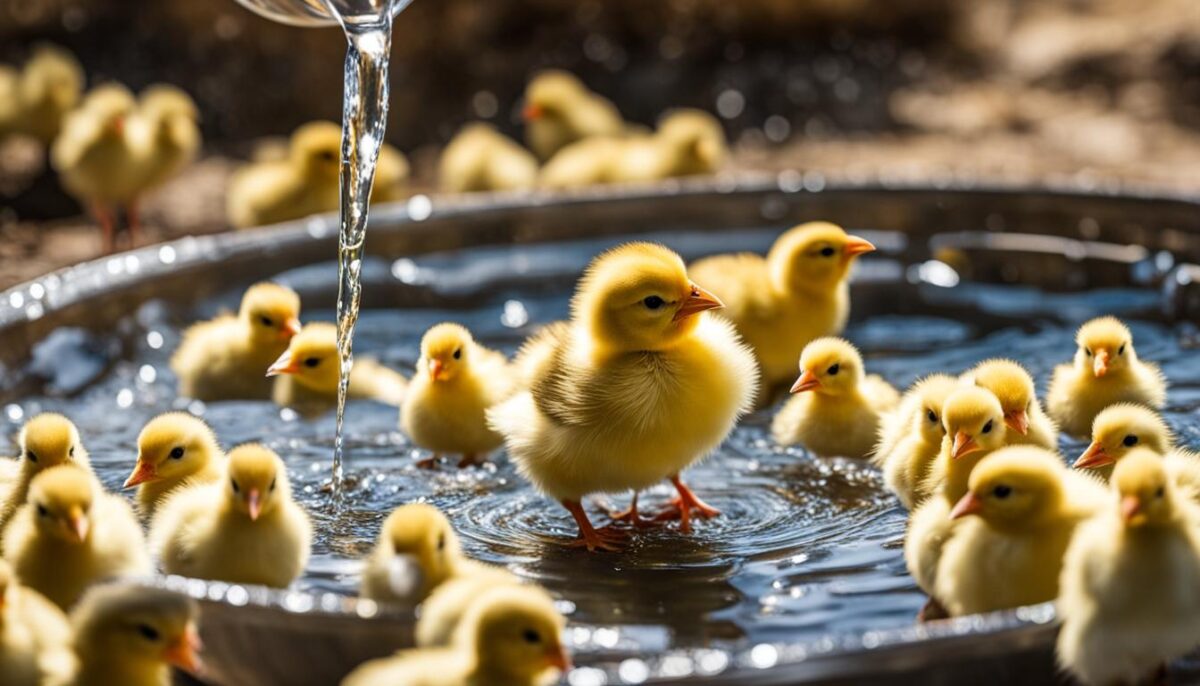
When introducing water to your baby chicks, it is recommended to use a shallow metal container to prevent drowning. Chicks instinctively know how to drink water, but it is a good practice to dip their beaks gently into the water to encourage them to drink. It’s important to offer water before introducing food to ensure they have taken a drink and are properly hydrated.
As for their diet, providing appropriate feed is crucial for the optimal health and growth of baby chicks. A balanced chick starter feed is recommended, as it contains the necessary nutrients and proteins to support their rapid development. The protein requirements may vary depending on the breed and purpose of the chickens. Laying hens or dual-purpose breeds require around 16 to 18 grams of daily protein, while meat birds may need up to 23 grams of protein for the first three weeks of their life.
The Importance of Water
Water is a vital component of a chick’s diet, accounting for approximately 70% of their body weight. It is essential for maintaining proper body temperature, supporting digestion, transporting nutrients, and eliminating waste. By providing clean and fresh water, you can ensure that your baby chicks stay hydrated and healthy.
Appropriate Feed for Optimal Health
Choosing the right feed is crucial for the optimal health and growth of baby chicks. A balanced chick starter feed is specially formulated to meet their nutritional needs. It provides essential proteins, carbohydrates, vitamins, and minerals to support their growth and development. Additionally, organic chick starter mixes and vegetable scraps can be offered as supplemental feed to promote a varied and nutritious diet for your chicks.
| Chick Type | Protein Requirement |
|---|---|
| Laying Hens or Dual-Purpose Breeds | 16-18 grams of protein per day |
| Meat Birds | 23 grams of protein for the first 3 weeks |
Supplementing Chicks’ Diet with Grit and Calcium
When raising chicks, it’s important to provide them with a balanced diet that includes essential nutrients for their growth and development. Two key elements to consider are grit for digestion and calcium for eggshell quality. Grit is necessary for chicks because, unlike adult birds, they lack teeth and need help breaking down their food. It acts as an aid in their digestive process, helping them grind and digest their food properly.
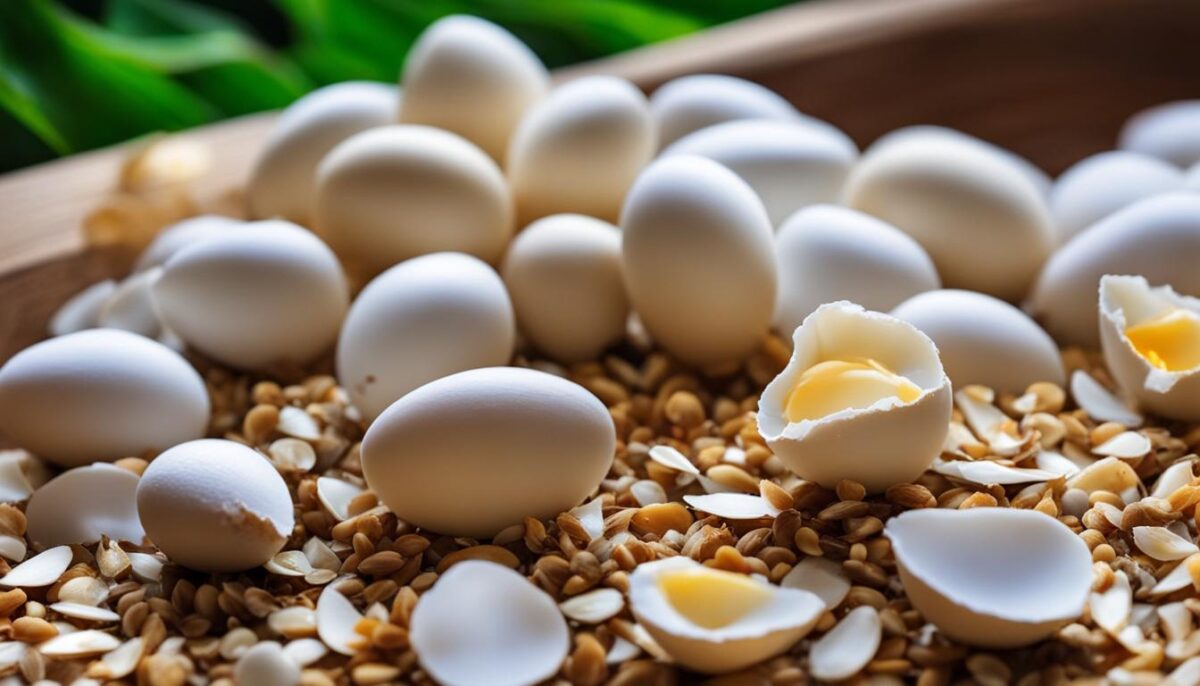
Another crucial element for healthy chick development is calcium. Calcium plays a vital role in the formation of strong eggshells for future laying hens. It is important to supplement their diet with an adequate source of calcium to ensure proper eggshell quality. Ground oyster shells are commonly used as a calcium source, providing the necessary minerals for strong and durable eggshells.
By providing chicks with both grit and calcium, you are ensuring their digestive health and promoting strong eggshell formation for future laying hens. These essential elements contribute to the overall well-being and development of your chicks, setting them up for a healthy and productive life as they mature into adult birds.
Tips for Keeping a Happy Chicken Coop
Keeping a happy chicken coop involves several key factors to ensure the well-being of your flock. By providing adequate space, maintaining cleanliness, and allowing for mixed ages within the flock, you can create a harmonious and healthy environment for your chickens.
Adequate Space Requirements
One of the most important aspects of keeping a happy chicken coop is providing enough space for your flock. Overcrowding can lead to stress, aggression, and the development of negative behaviors such as feather picking. The general rule of thumb is to allow at least 4 square feet of coop space per chicken. Additionally, the outdoor run should provide ample space for the chickens to roam and forage.
Maintaining Cleanliness
Regular cleaning is essential to ensure a clean and healthy environment for your chickens. Clean out the coop and nesting boxes regularly to remove any droppings, soiled bedding, or potential sources of odor. This helps prevent the buildup of bacteria and parasites, which can lead to health issues. Provide fresh bedding in the coop and nesting boxes to keep the area clean and comfortable for your chickens.
Mixing Ages in the Flock
Introducing chickens of different ages can be beneficial for the overall dynamics of your flock. Older chickens can provide guidance and establish a pecking order, while younger chickens can bring energy and vitality to the group. When mixing ages, it’s important to ensure that the younger and smaller chickens are not excessively bullied by the older ones. Observing the dynamics and providing separate feeding and watering areas can help minimize conflicts.
By following these tips, you can create a happy and healthy chicken coop environment for your flock. Providing adequate space, maintaining cleanliness, and introducing mixed ages within the flock contribute to the overall well-being and happiness of your chickens.
| Benefits of Mixed-Age Flocks | Considerations for Adequate Space | Benefits of Maintaining Cleanliness |
|---|---|---|
|
|
|
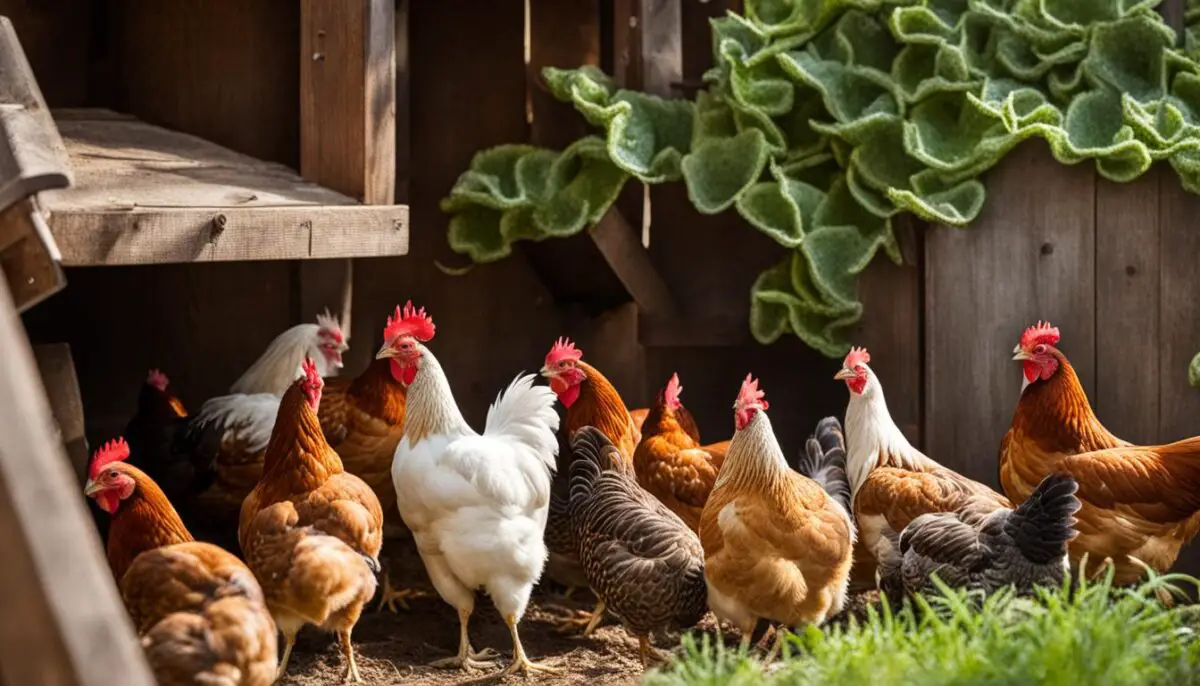 |
Conclusion
Raising fully feathered chicks at home is a fulfilling and enjoyable endeavor. By considering factors such as age, feathering, temperatures, coop requirements, and nutrition, you can ensure the well-being of your chicks and the success of your flock.
Providing a safe and comfortable environment for your chicks to grow is crucial. Ensuring that the coop meets their needs, such as predator-proofing and sufficient space, is essential for their safety and happiness.
Proper nutrition plays a vital role in the development of fully feathered chicks. Providing a balanced chick starter feed and access to fresh water are key elements in supporting their optimal health and growth.
With careful attention to these factors and plenty of love and care, you can raise happy, fully feathered chicks at home, creating a thriving and vibrant flock that will bring you joy for years to come.
FAQ
When can fully feathered chicks be moved from the brooder to the chicken coop?
Fully feathered chicks can be moved to the coop when they are around 6 weeks old and can tolerate outdoor temperatures without the need for supplemental heat.
How can the stress of moving chicks to the coop be minimized?
To minimize stress, it is important to keep the chicks inside the coop for several weeks prior to allowing them access to the run. This helps them establish a sense of home. It’s also important to prevent the chicks from sleeping in the nest boxes.
What should be considered when integrating chicks into an existing flock?
It is best to wait until the chicks are closer in size to the mature birds before integrating them. The process should be slow and deliberate to minimize conflict and stress for both the chicks and the older flock members.
Do chicks need a heat source when moving to the coop?
The need for a heat source depends on the temperatures and the number of chicks. If the temperatures remain above 65°F and the chicks are at least 6 weeks old, they can move into the coop without supplemental heat. Larger numbers of chicks can generate more body heat and keep each other warm.
What should be considered when preparing the coop for the chicks?
The coop should have access to electricity if a heat source is required. It should also be secure and predator-proof, using hardware cloth to keep predators out and chicks in. Safety measures should be in place to prevent predators from getting into the coop.
What is needed to properly care for baby chicks?
Baby chicks require a brooder setup with high sides, proper bedding, and a heat lamp to keep them warm. Fresh water should be provided at all times, and they should be fed a balanced chick starter feed.
How long should the heat lamp be used for chicks?
Chicks should be kept under the heat lamp for the first 2 weeks at 95°F and then gradually reduce the temperature by 5°F per week. By 6 weeks of age, most chicks are fully feathered and can tolerate outdoor temperatures.
What is the importance of water and food for baby chicks?
Water is more important than food initially, and a watering container should be provided to prevent drowning. The appropriate feed for chicks depends on their protein needs, and supplemental feed such as organic chick starter mix and vegetable scraps can also be provided.
Do chicks need grit and calcium in their diet?
If the chicks are not on bare ground with access to dirt, they should be provided with grit to help them digest their food. Calcium supplementation is also necessary to ensure good eggshell quality, and ground oyster shells or other calcium sources can be offered to the hens.
How can a happy chicken coop be maintained?
Providing enough space for the flock, ensuring clean water and feeding troughs, and maintaining cleanliness are important for a happy chicken coop. Regular cleaning of the brooder box and coop is essential, and chickens of different ages can be mixed if they have enough space and are properly introduced.
What is the key to raising fully feathered chicks at home?
The key is to carefully consider factors such as age, feathering, temperatures, coop requirements, and nutrition. By following the appropriate guidelines and providing proper care, you can raise a healthy flock of fully feathered chicks.


